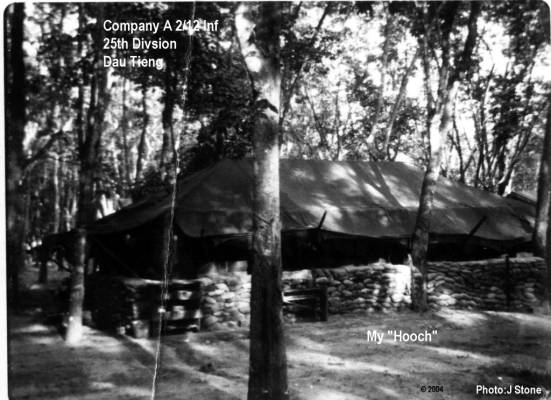
Back At Base Camp Rainier
Well… we made it back to camp. Once again I am forced to take my chances of
survival with the cooks…Just kidding…I love these guys!
It’s always nice to get back to base camp in the least amount of time, the least
amount of effort and no casualties—at least on our side anyway. Pretty much had the
rest of the day to ourselves.
While in base camp many of the guys would go to the EM (enlisted men’s) club for a beer.
Others would just hang around the company area and wait for the mortars (Explosive shelling) to come in.
A typical day or night off, I would hang around the hooch (see photo 42) and write
some letters and write about all the crap that happened.

Photo 42. My Living quarters— Stayed in 3rd platoon hooch
Sometimes I’d get together with Bill Klevins (see photo 43, taken at the bunker line)
and play our Vietnamese acoustic guitars.
One night in particular there must have been six to ten
other guys in one of the hooches, listening to Bill Klevins
and me play some blues and rock & roll. Then we discovered
that Doug Buhl and Bill Carle were real good singers
and they’d take turns singing some songs while we provided
the music. Pretty sure it was Bill Carle started singing
a song called "Funky Roberta” and taught the rest of the guys
the back up chorus. The funniest damn song I ever heard!
Boy it was really something! So I grabbed my little tape
machine and recorded the show for posterity.
(Song one on disk: “Funky Roberta” with Bill Carle singing
lead vocal. Song two on disk: “Run Away” with Doug Buhl
singing lead. Both songs with me playing lead and rhythm
/ Bill Klevins playing chords and the guys in the hooch
singing back up. Click here to hear the tapes made in 1967!
Not really sure if it was exactly this night, but one of our
performances got rudely interrupted. Right in the middle of a
solo, someone outside started yelling, ”Incoming, Incoming!”
Maybe our VC neighbors didn’t like the music. They sent in Photo 43. Bill Klevins-
a pile of mortar rounds right into the company area. Boy did we Guitar pickin' buddy
scatter! I started running toward the bunker but the mortars were dropping right in the area so fast and
precise my pathway got cut off. I had to turn around and run back. Some of the guys dove into the water
trench near the road and I found myself trying to bury my head into a wall of sandbags right at the outer
protective wall of the hooch. What a Jerk! I would have been better off just staying inside and laying low.
When the shells from one of these little cannons hit, they make an exploding sound that is very hard
to describe, but once you’ve heard it, you will never forget. Not exactly like a BOOM sound…
Possibly like a crunching noise! Possibly, with some imagination, like the sound a large paper grocery
bag makes as it opens up while the bag is violently swung through the air, but a whole lot louder!
Crunch! —Crunch! Maybe like the sound of the air escaping from a steam locomotive engine just
when the wheels begin to turn on initial startup—then speeds up—Puufff! —Puufff! —Puufff! —
(click here to hear incoming mortars taped in 1967, very realistic, be aware!) Never did understand
how the VC was able to drop those babies into that tube so fast while changing the strike path? The VC
must have dropped in at least ten of those things, walking them through our area to the company
next door! After it was over I told the guys, ”Jeez — I know they made lousy guitars, but the music
wasn’t really that bad!”
Base camp wasn’t all fun and games but we sure made the best of it the few times we were there.
DAY TWO
Even though I had a good breakfast, I asked the cook, “Hey, in case I need to go on sick call, what should I tell Doctor Rhodes you guys served today? The last time he asked what I had eaten, I had trouble describing it!” Without waiting around for a answer, I hurried out of the mess hall to get my gear. By the time I got fresh water in my canteen, the company was ready to hit the road again.
We left base camp and stopped at the roadside just out side one of the main perimeter checkpoints and waited for some heavier security than the rat patrol jeeps. About fifty tons heavier! Our security was a 51-ton tank with the name the “Baron” painted on the side of the turret.
Our company was lined up on the sides of the road as the Baron rolled towards us (see photo 44). The closer it got, the smaller I felt. The Baron was huge (see photo 45). I didn’t get real close but I’d be lucky if my height would allow me to see much over the top of the track treads. I was feeling much safer with the tank along with us.

Photo 44. The tank named “The Baron”
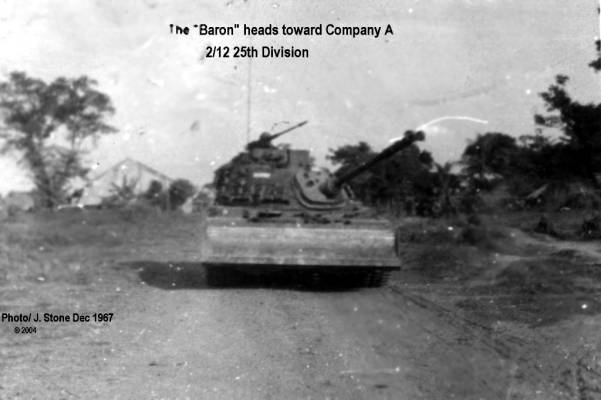
Photo 45. The “Baron”
I am not sure when the engineers and minesweepers joined us. According to my diary and photos, the EOD or Explosive Ordinance Disposal unit was not with us the first day.
These engineers (see photo 46) attached to our company, consisted of five demolition experts. These minesweepers, as they were called, would use electronic mine detectors to check the road for any buried mines. When the engineers would detect a mine in the road, they would investigate it closer by probing the area by hand, with a bayonet. If they found one, we would give them plenty of distance and they would put a charge of C-4 plastic explosive on the suspected area or mine and blow it up (see photo 47). If by chance it really was a mine they were detonating, it could leave a pretty large size hole (see photo 48) in the road. One engineer told me the detector worked well on metal mines but it was useless on non-metal powder type or buried plastic explosives, such as C-4. Those had to be hand probed. Probing a command-detonated mine was suicide if a VC was on the end of the wire with a remote trigger—the enemy could blow one of these on “command”, at any time they saw fit. I was told they lost one of their engineers the first day at the other end of the road while he was probing the road with his bayonet. The explosion killed him instantly.
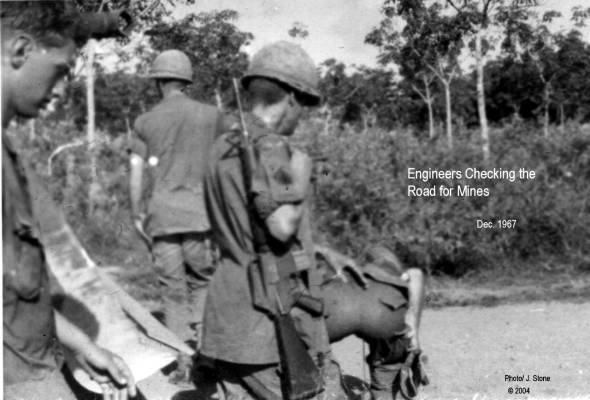
Photo 46. “The minesweepers”

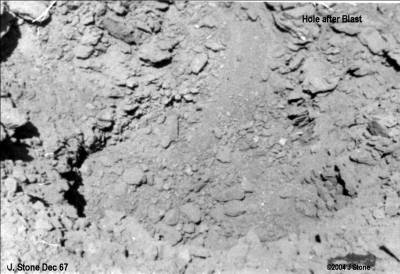
Photo 47. Blowing a mine Photo 48. Hole after blast .
As the Baron and engineers were in lead position, the company trailed behind them as they inched their way down the road. While the minesweepers checked the road, the company was checking ID’s of approaching villagers. I kept my eyes open for anything that looked suspicious, or even obvious, such as a walking booby trap. It wasn’t long before the company (see photo 49) started to spread out—not walking to close to one another.
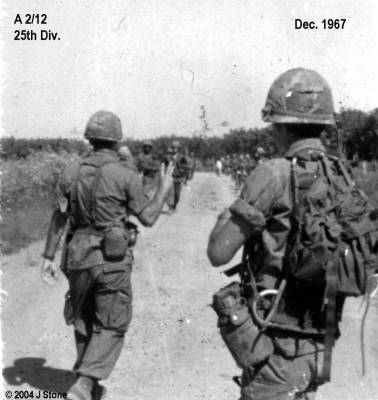
Photo 49. Officer on left carrying an Ar-15 and left handed— not sure who.
At some point along this road, I took a photo of Sgt. Draughon (see photo 50) walking at a distance behind the rest of the CP Group.
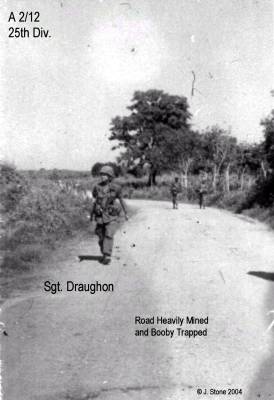
Photo 50. Sgt. Draughon —trailing the CP Group
We got to a bridge the VC had already blown up. The bridge was in rough shape but I don’t think it was actually or presently in use. The CP group navigated around the right side of it with the Captain. Captain Merrill (see photo 51) went to take a look and stood at the edge on high ground.
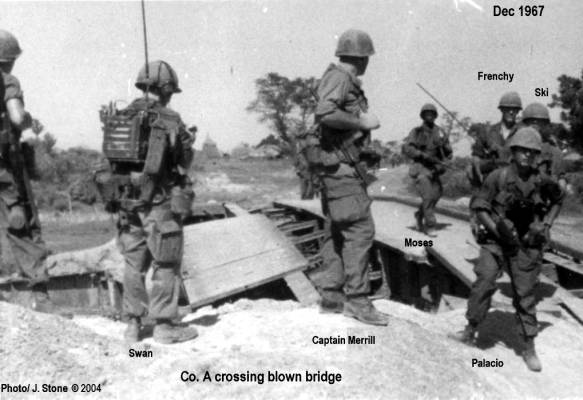
Photo 51. Captain Merrill and Swan wait for Palacio, Ski, Frenchy, and Moses to cross bridge blown bridge.
I took a few group photos of some of the company coming over it as they passed by the Captain. One photo shows Sgt. Todd in the foreground and behind him are Lt. Harris, Frenchy, Ski, Moses, Palacio, and another guy on bridge center. (See photo 52) We waited there for a while for the engineers to assess the situation. These multiple photos show a sequence of the guys coming over the bridge (see photo 53). Also, for the record, Frenchy evidently is not driving the jeep this day.
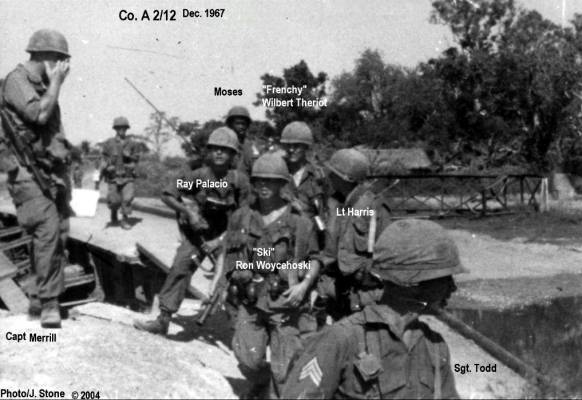
Photo 52. Shows Sgt Todd in front, Ski, Lt Harris, Frenchy, Palacio, Moses, and the Captain on the left.
After everyone passed over the bridge and the civilians were out of the way, it was decided the tank would do some recon fire.

Photo 53. Ray Palacio still in the same spot as more of Alpha Co. cross
The tank (see photo 54 and 55) was put in position to shoot along the road surface with machine gun rounds. The game plan was, if one of the machine gun rounds happened to hit a mine or explosive device planted in the road, it would blow. I thought the chances of hitting one were pretty pathetic. I may have been proved wrong. I recall at least one round creating more than just dust. Much more. The round had to have hit something in the road to make such a cloud of dust. The recon continued on the road surface for a while and then the target was adjusted into the wood line. (See photo 56) This gun was extremely loud. Even the Captain plugged his ears with his fingers. After the gun smoke cleared, the company continued down the road.

Photo 54. The Baron gets into position to fire

Photo 55. The Baron prepares to fire
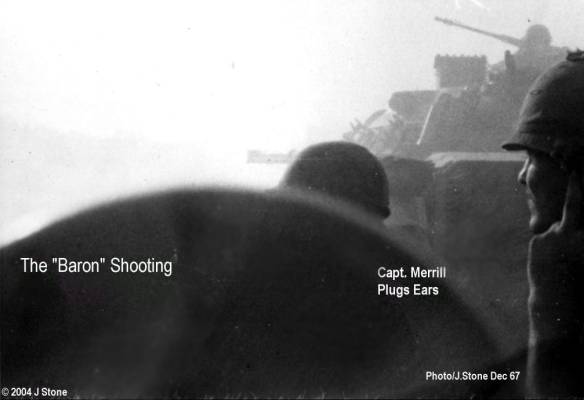
Photo 56. The Baron firing a machine gun
The engineers were up with the front of the company with the tank. At a distance of two hundred feet or so, we moved behind them as they cautiously checked the road for any indication or markers for mines. When they suspected anything, they would tell us to hold up and then detonate the mine by setting off a charge. Some of the holes left from detonated mines were large enough to fit a jeep in—well, at least part of it anyway. (Photo 57) As some of the guys walked by some of the craters left by an exploded mine, one of them looked at me and shook his head side to side…as if a person was indicating “no” by shaking his head. I assume he was thinking “unbelievable” or a “what a big freakin hole”… I know what I was thinking. I hope these sweepers don’t miss any of these things.
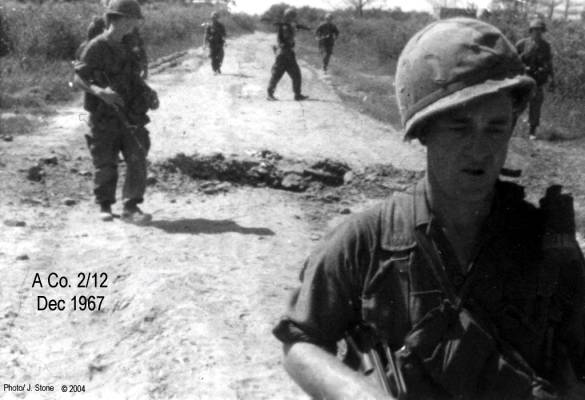
Photo 57. The hole from a blown mine
Sometimes it was hard for me to tell if the engineers were actually blowing up an explosive device in the road or just using a lot of explosives themselves.
I had just got done taking my camera out of my pocket and put it up to my eye to take a shot and suddenly there was this large explosion down the road. (See photo 58) At first we all thought it was just another explosion the engineers set off. I took a picture of this blast, and as I removed the camera from my eye, I heard someone in the group yell, “ Oh shit!” Instantly, the CP group started running.
I was running toward the blast and I still wasn’t sure what happened, but I know I couldn’t see the Baron anymore. All I saw was dust and smoke. There wasn’t any big flash, and it really didn’t make a hell of lot of noise. More like a muffled thump. I believe I felt it more than anything else.
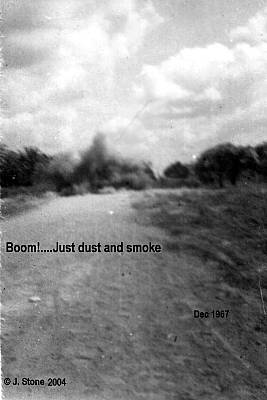
I don’t really know when I was fully convinced the explosion wasn’t just another big charge set off by the engineers. Maybe when I got near the cloud of dust…maybe as I passed a soldier, who was crouching at the right side of the road… Quite possibly, I was fully convinced the tank was blown up when I saw what was lingering above the tank. An account of what I saw follows…
As I came up to the rear of the tank, I passed someone crouching just off the right side of the road near a bush. I continued to follow the CP group and about half way down the side of the tank, I paused behind Sgt. Draughon. I couldn’t see a freaking thing. I had Sgt. Draughon in front of me, the tank on the left and this big freakin’ bush on my right.
As we were moving again, I looked up to see if anyone else was still on the tank and I couldn’t believe what I was seeing.
Hovering up in the air, around twenty feet or more above the tank Photo 58. Just dust and Smoke was this huge unbroken smoke ring. It appeared to be perhaps twenty feet in diameter and was off-white in color—maybe grey. The instant I saw it, I knew exactly how it was created. I’ll cover more about this smoke ring later.
I continued to follow Sgt Draughon. When we reached the front of the tank, there were two guys lying on the ground. I assumed one was the gunner and the other was the driver.
The driver never had a chance. The explosion from under the tank had blasted the driver out of his seat. I’m reluctant to make such a callous description of what I saw, but what was left of him could have fit in a duffle bag with room to spare. The majority of him ended up on the ground at the right front corner of the tank. It appeared at least one of his limbs remained on the tank, centered under the gun barrel. I assume he was killed instantly, suffering no pain.
The tank gunner was on the grass, face up motionless. When I first saw him, I had a tough time making out if he was “ toast” or a black guy. God, I hoped he wasn’t toast. He was all covered in what appeared to be black soot making it obvious he must have been right in the midst of the blast. His t-shirt color blended right in with his skin. Even his fatigue trousers, except for the wrinkles, were highlighted in black soot. I distinctly saw a wound on his hand and wrist, pink in color, but not bleeding. I do not know if he jumped off the tank after it blew or was catapulted here by the blast, but it certainly would have been a long jump.
I moved around Draughon’s right side and faced towards the side of the road to give them some cover. I thought for sure we were going to get ambushed so I crouched down and looked out into the field for incoming fire from out of the wood line.
To describe these previous scenes in words makes it appear it took a long time to travel from my arrival at the rear of the tank to the front of the tank. It wasn’t really a heck of a long time. Total elapsed time: I doubt more than thirty seconds.
While giving coverage to the wounded GI at the front of the tank, I took a photo (See photo 59) while we waited for the Medevac chopper to arrive. I believe (but not positive) it was Draughon crouched at the casualty’s head. In addition to the tank, Draughon’s knee and gun barrel appear in the photo.
I really couldn’t see into the field very well. My view towards the field was obstructed by a bush at the shoulder of the road and interference from few more bushes in the field.
Once again, I moved a short distance past the shoulder of the road and positioned myself to the left side of the bush. From that location I could I see quite a bit more. I checked the field and the dense foliage in the distance. I was ready with my M-16 on semi-automatic and two of my magazines in my top pocket for quick access.
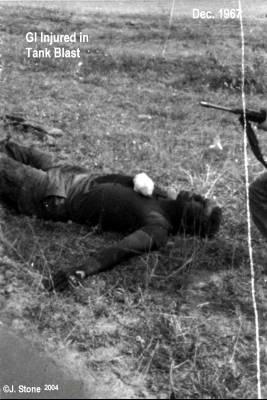
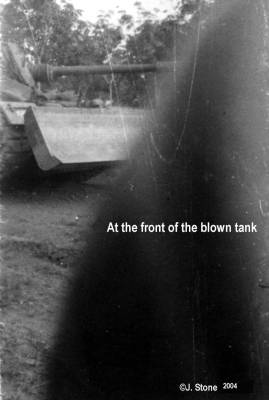
Photo 59. Tank Gunner injured in blast Photo 60. A botched one-handed photo
I turned around to see what was going on. I quickly took a one-handed picture and turned back to the field. The photo was botched. (See photo 60) All I got was the tank.
When I turned around toward the tank to see what was happening, I saw another man down behind the tank. I said, ”Where the hell did he come from?” He wasn’t there a minute ago! At least I don’t think he was. He was lying on his left side with his feet pointed toward the rear of the tank. I believe it was one of the engineers, but I am not sure. If he had been there when I first got to the tank, I would have had to walk over this guy to get down the side of the tank. Therefore he must have just recently got there in the last minute or so. There is no freaking way I came down the side of the tank and not see this guy.
After I became aware of this GI behind the tank, I observed what appeared to be a company medic heading toward the tank and me. I pointed three times in rapid succession towards the guy at the rear of the tank and returned my attention to the field.
I turned around and took a photo of the (assumed) medic (See photo 61) attending to the injured man behind the tank and turned back to watch the foliage border in the distant field.
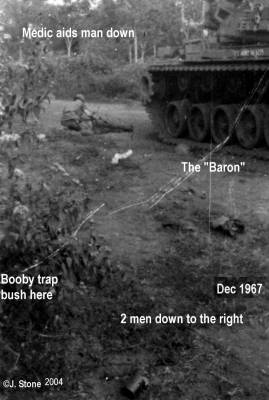
Photo 61. Man down behind the Baron
The tank gunner and driver are just to the right….
and the bush on the left is about to blow!
I wasn’t at this last location long. Sgt. Draughon told me the Medevac (medical evacuation) chopper was coming and to secure an area for it to land to evacuate the wounded. I moved away from the bush, and headed for the open field.
God, I felt so alone out there in that field—like a sitting duck—no cover—just a small log laying in front of me and a couple of bushes which were all behind me. I had this unusual wide-open feeling—like the opposite of claustrophobia— whatever that is? Laying down in the prone was useless to see toward the wood line—I had to crouch and kept raising my head up and down. Half the time I was wondering what was going to come in first—the dust-off (Medical Evacuation) chopper or incoming fire out of the foliage border. It wasn’t long before the bird (helicopter) was down.

Photo 62. Medical Evacuation Chopper- dust-off to pickup wounded
With the chopper on the ground, it was really kicking up the dust from the roadbed. Looking through the dust, I couldn’t see much past a bush in the field that was in line of sight with the chopper. It (See photo 62) appeared to be three or four guys at the chopper door and they were loading or preparing to load in the WIA’s (wounded in action). I whipped out the camera and snapped one off and turned back to watching the field. Every once in a while I’d turn around to see what was going on…I saw this guy running from the chopper and I took his picture. He was running towards the tank and Sgt. Draughon, who was bent over at the right side of the bush. Draughon and another guy were both at the same bush I was at before. (See photo 63)

Ph0to 63. There are at least five soldiers in this photo.
Then next thing I heard was another explosion. It wasn’t very loud. Maybe muffled because of the chopper noise. I heard later, shrapnel from a booby trap in that bush, which was located at the side of the tank, wounded Sgt. Draughon and another guy. Supposedly the other guy was Morales. That was the last time I ever saw Sgt Droughon or Morales. Shit! That could have been me. [More on that later.]
After the chopper left with the wounded and the dust settled, it was so clear. More clear than you can imagine. The whole thing was a planned setup. From the VC’s point of view, it was an effective one too. I guess from our viewpoint too. Mine the road and booby-trap the bushes near by. From that day on, in a circumstance like that, I tried to avoid using bushes for cover as much as I could. Prone position, or even squatting in an opened field, proved to be much safer.
I don’t remember how long I remained in that field, but I remember feeling a bit relieved we didn’t get ambushed—always a very vulnerable time when evacuating wounded. It’s hard to hear above the chopper noise, and hard to see clearly through the dust. It’s even more of a risk evacuating at night.
When I got back to the road, I took a few pictures of the front of the tank and the driver that remained there. He was neatly covered up with a poncho (see photos 64 and 65).
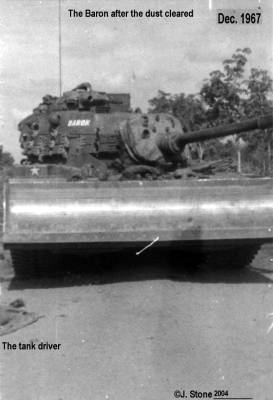

Photo 64. The Baron after the dust cleared Photo 65.The “Baron and Driver
We lost our security. The Baron was about as useful as a fifty-ton paperweight. We left it there in the road. While the company reorganized, I took a photo (see photo 66) of Sgt Todd and Lieutenant Harris. I asked if they were going to just leave the tank there and someone said it would be towed back into camp later. I was really surprised they did that. Not knowing much about tanks I said, “I hope someone’s got the (ignition) key to that thing.” I really didn’t know if some VC or Papa San (Adult Vietnamese male) could come along and take it for an afternoon joy ride.

Photo 66. Sgt Todd and Lt. Harris
At some point in time here, I noticed my weapon was still on semi. I’m always forgetting that. I called my self some type of idiot and turned it back on safe.
With the company reassembled we moved down the road keeping it spread out in case Charlie (Viet Cong) decided to blow more mines and also to make less of a target, should we get ambushed. The engineers continued to check the road. No one got near the guys probing for mines. (See photos 67 and 68) In the background, the Baron was abandoned in the road.

Photo 67. The Baron abandoned —mine sweeper probes road

Photo 68.
We ended up at a farmhouse or possibly a small village. While some ate some rations others just took a break. I wasn’t very hungry so I walked back and forth between Lt. Harris and the Captain, keeping a careful eye on those hooches (see photo 69) that were positioned behind them.

Photo 69. Alpha company stopped here to take a lunch break.
Lieutenant Harris and his RTO, Ray Palacio, have a picnic lunch. (See photo 70)

Photo 70. Lt. Harris and Ray Palacio
Titled 3-6 and 3-6 X-ray according to my album
Captain Merrill relaxing under a tree. (See photo 71)
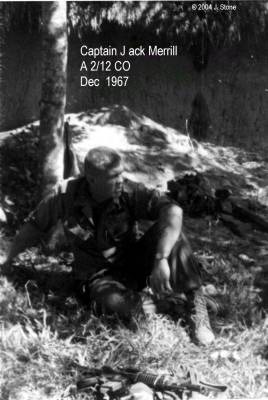
Photo 71. Captain Merrill
Some were looking at maps and talking about route numbers. Maybe route thirteen or fourteen and some other roads or areas were mentioned. Captain Merrill brought in some artillery on some of the suspicious areas. As the artillery was coming in, it sounded so much like thunder. When it was quiet, I said,” They should have called it Thunder Road.” One of the guys said, “ That’s fitting—sounds pretty good to me.”
I am puzzled why I can’t remember much of the rest of the trip back to base camp, but possibly just because it was un-eventful. Who knows? Maybe I just don’t remember because my memory is jammed full with what happened today. I’ll have to take better notes for the photos. I have to assume we humped back to base camp and passed by the Baron. It was still in the road but the tank had been moved a few feet away from the killing zone, revealing the crater caused by the blast. (See photo 72)
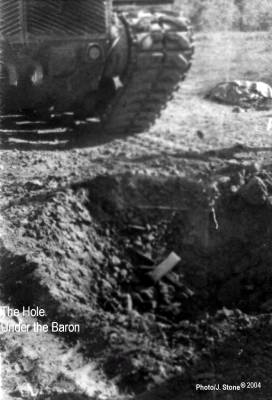
Photo 72. Crater from blast under the Baron